Aebleskiver, Denmark’s answer to the doughnut
COPENHAGEN — Ask any Dane or Danish-American about aebleskive, and you’ll be treated to broad smiles. Aebleskiver –literally ”apple slice” — is a pancake puffball that rarely contains the apple tidbit originally tucked into its center as a sweet surprise.
But the name, pronounced ay-bla-skeever, has stuck. Gone in two bites, this traditional Danish dessert, sprinkled with powdered sugar and served with raspberry jam during the holidays, is made in a cast iron pan that resembles an egg poacher, with seven round depressions. It is placed directly atop a flame.
The batter bubbles, the puffs are turned with a knitting needle, and soon the aebleskive are rolling from the pan. Eaten warm, they are downed before the powdered sugar dust has a chance to settle.
Most Danes have their own aebleskive pans. In the houseware section of Ilum’s, a department store on Copenhagen’s main shopping street, Heidi Hansen showed me the latest in nonstick aebleskiver pans.
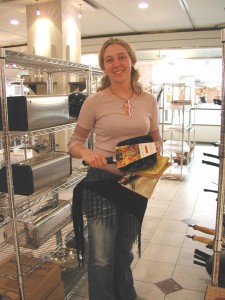
”When I was a child,” she said, ”we visited my grandfather in the country. He made the best aebleskive for me and my sisters. I remember setting the table and having a very cozy, warm, familiar feeling.”
The following day, by arrangement, Hansen brought her mother’s batter-stained cookbook with her aebleskive recipe translated into English. ”If we had time, I would make you some,” she said.That evening I asked friends about aebleskive, which are only available during the Christmas holidays, and if they knew where I could get the pancakes out of season. Geir Helgesen, a political analyst, told me about a restaurant 20 miles outside of Copenhagen that is famous for serving aebleskive year round. A day trip along the Danish coast could, he assured me, conclude with tea and aebleskive at the Malerklemmen Restaurant in the tiny town of Borup, a speck on the map. The Malerklemmen website (www.malerklemmen.dk) said that the restaurant is open 12 to 5 p.m. on Saturdays. My husband and I found ourselves happily but hopelessly lost in the tidy Danish countryside, where our maps weren’t helpful. A kind soul led us to the restaurant. It was 4:10 p.m. Thankfully, we thought, there still was plenty of time.
We entered the centuries-old building with its thick thatched roof and the waitress informed us that the kitchen had closed 10 minutes ago. The owner, Michael Strand, heard me pleading with the waitress and came out from the kitchen. He showed us two huge, multiholed pans: ”On some Sundays I make over 2,500 aebleskive,” he said, adding that he carefully turns each with a knitting needle.
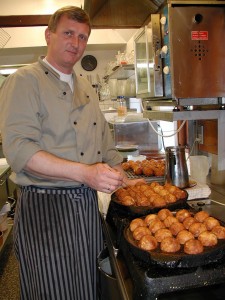
Strand arranged some warm aebleskive on a plate with a bowl of jam. Sitting at a wooden table in a converted tenant farmer’s home beneath antique aebleskive pans, we would finally taste one.
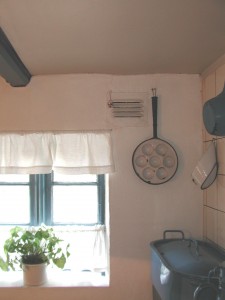
It looked like a very puffy doughnut hole, and its texture was a cross between a doughnut and a pancake. It was not overly sweet, but just right with a dab of jam and a cup of late afternoon coffee or tea — well worth the long trip.
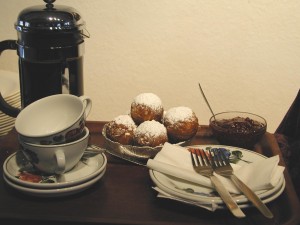
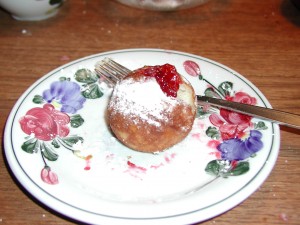
Danish-Americans don’t save aebleskive for the holidays but eat them year round whenever families get together. At breakfast, they are most like pancakes, enjoyed with syrup and sausages. According to Lisa Rigg of the Danish Windmill Museum in Elk Horn, Iowa, this drives some Danes to distraction:
”As Danes assimilated into American society, breakfast seemed the natural spot in the American meal for aebleskive.” When the museum holds its annual Tivoli Fest on Memorial Day weekend, ”folks come from all over for our aebleskive,” Rigg says. Elsewhere in the Midwest, and wherever else Danes settled, aebleskive are sold at church fund-raisers. There are aebleskive festivals and aebleskive cookbooks, and in Solvang, Calif., named for a town in Denmark, aebleskive are sold on the street to summer tourists.
Brookline resident Ingrid Finstuen is learning to make aebleskive. Her Norwegian-American husband, Andrew, said, ”I remember being intrigued by the pan my mother used and the way she turned them with a poker.” Andrew Finstuen’s mother, Kappy, recalled how her Danish neighbor in Oregon, Lucille Stubkjaer, made hundreds of them for her wedding breakfast. Kappy Finstuen coached her daughter-in-law in the art of rotating an aebleskiver last summer. ”I love them with fresh raspberries and sour cream,” says Ingrid Finstuen.
Making aebleskive at home isn’t difficult. The batter is a little thinner than for ordinary American pancakes. Getting the pan to the right temperature is important, as is greasing the little holes, for which you use melted margarine or butter.
Turning the pancakes is tricky, but with a little wrist action and confidence, you’ll be on your way. That just leaves the pan, also known as munk pans in Germany. You can find these seven-holed cast iron pans in many kitchenware shops and online. And of course electric ones are now available. However you can also locate something similar in Chinatown (Vietnamese cooks make banh khoc, savory pancakes that use the same pans), and you can use knitting needles from your own collection.
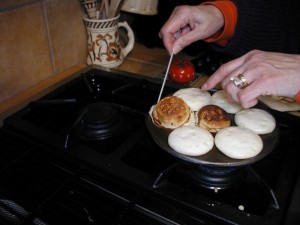
Now say ”aebleskive” three times fast.
Super 88 and the Ming Market have seven-hole cast iron pans
($6.95). Look in the pots and pans aisle. Or go to
www.fantes.com/aebleskiver.htm; http://www.cookscorner.com/, or
http://www.danishwindmill.com/.

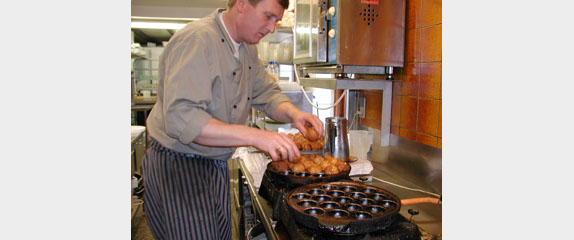









 Debra Samuels, bestselling author, food writer and cooking instructor,
Debra Samuels, bestselling author, food writer and cooking instructor, 


